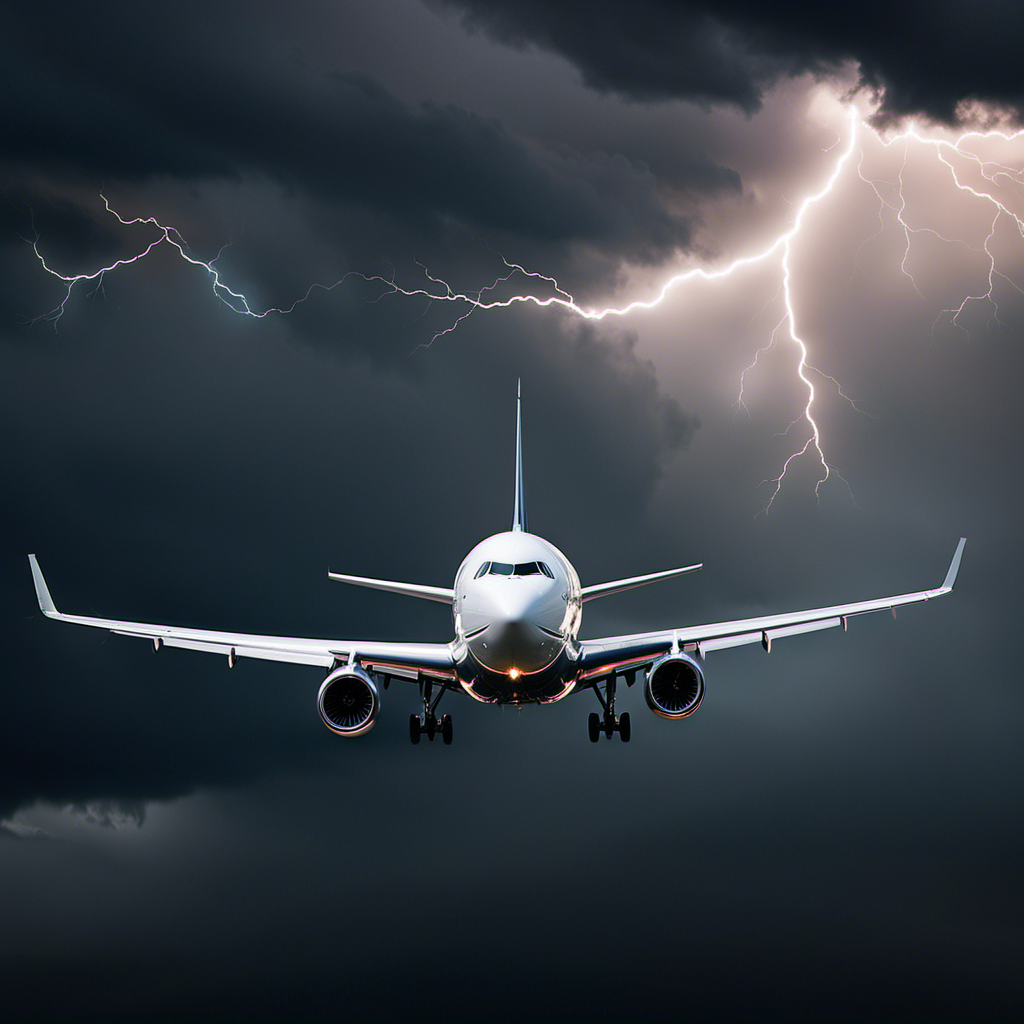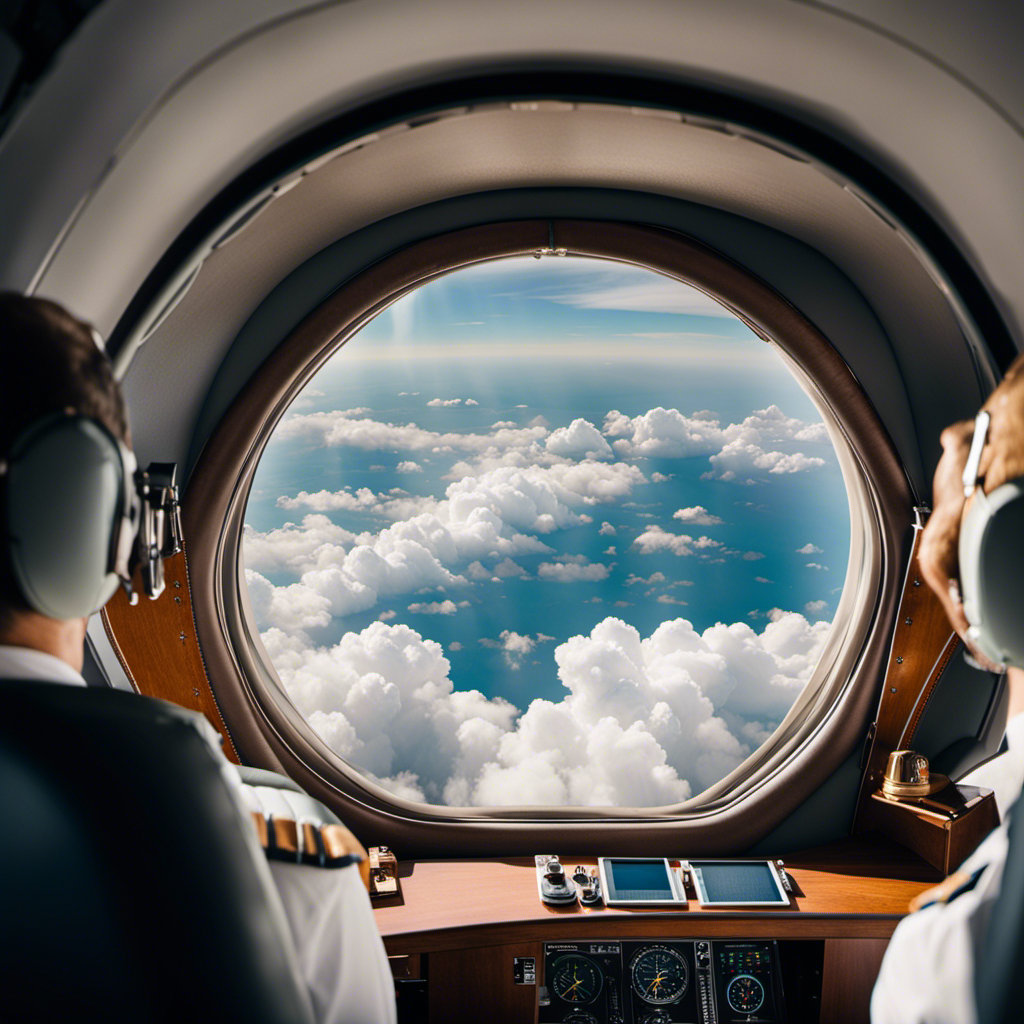As a frequent air traveler, I have often thought about the power of turbulence and its potential to flip an airplane. In this article, we will delve deep into the technical and analytical aspects of this question.
We will explore the causes of turbulence, the different types it can take, and the impact it has on passengers. Additionally, we will examine the role of aircraft design, how pilots handle turbulence, and the influence of altitude.
Through research and development, we aim to shed light on this myth while enhancing passenger education and awareness.
Key Takeaways
- Turbulence can be caused by various factors such as wind shear, atmospheric instability, mountains, thermal turbulence, and shear turbulence.
- Turbulence can lead to physical discomfort and psychological effects for passengers, highlighting the importance of education and reassurance from pilots and flight attendants.
- Aircraft design incorporates safety measures such as wing dihedral, optimized fuselage and wings, and advanced flight control systems to ensure stability in turbulence.
- Pilots employ techniques such as relying on weather reports, using onboard weather radar systems, and making altitude changes and course adjustments to minimize the effects of turbulence.
What Causes Turbulence in the Sky
Turbulence can be caused by a variety of factors in the sky. Understanding the causes of turbulence is essential in ensuring safe and comfortable flights.
The physics of turbulence is complex, but it can be simplified to explain the main factors contributing to its formation. One major cause is wind shear, which occurs when there is a sudden change in wind direction or speed. This can create turbulent eddies in the atmosphere.
Another factor is atmospheric instability, which can be caused by temperature variations and moisture content. When warm and cold air masses collide, they create turbulent conditions.
Additionally, mountains and large structures can cause turbulence by disrupting the airflow, creating pockets of turbulent air.
Understanding the Different Types of Turbulence
While flying, it’s important to be familiar with the various types of turbulence. Understanding turbulence dynamics and the factors affecting turbulence intensity can help passengers feel more informed and prepared during a flight.
Turbulence can be categorized into three main types: thermal turbulence, mechanical turbulence, and shear turbulence. Thermal turbulence occurs when warm air rises and mixes with cooler air, causing pockets of instability. Mechanical turbulence is caused by the interaction between the aircraft and the surrounding air, such as when flying over mountains or near buildings. Shear turbulence is created by a sudden change in wind speed or direction.
The Impact of Turbulence on Passenger Experience
Passengers may feel anxious during periods of turbulence, but understanding the impact of bumps and jolts on the overall flight experience can help alleviate their concerns.
Turbulence can cause passenger discomfort, both physically and psychologically. Physically, the sudden movements and changes in altitude can lead to motion sickness, headaches, and muscle tension. Psychologically, turbulence can induce fear, stress, and anxiety, especially for those who have a fear of flying.
Understanding that turbulence is a normal and predictable occurrence in aviation can help passengers cope with these feelings. Pilots and flight attendants play a crucial role in providing reassurance and maintaining a calm atmosphere during turbulent episodes.
By educating passengers about the nature of turbulence and its minimal impact on the safety of the aircraft, airlines can help alleviate passenger discomfort and mitigate the psychological effects of turbulence.
This leads us to the next section, where we will explore the role of aircraft design in turbulence safety.
The Role of Aircraft Design in Turbulence Safety
When flying, you might not realize that the design of the aircraft plays a crucial role in ensuring your safety during turbulent situations.
Aircraft stability and turbulence mitigation are key aspects of aircraft design that help pilots navigate through turbulent weather conditions.
To achieve stability, aircraft designers incorporate features such as wing dihedral, which enhances lateral stability and prevents the aircraft from rolling excessively during turbulence.
Additionally, the design of the fuselage and wings is optimized to reduce aerodynamic drag and improve control response, allowing pilots to maintain stability even in turbulent conditions.
These design elements, coupled with advanced flight control systems, contribute to the overall safety and performance of the aircraft during turbulence.
Understanding the impact of aircraft design on turbulence safety sets the foundation for exploring how pilots handle turbulence during flights.
How Pilots Handle Turbulence During Flights
Pilots use various techniques and strategies to manage and navigate through turbulent conditions during flights. Turbulence is caused by factors such as changes in wind speed and direction, atmospheric pressure, and temperature gradients.
To avoid turbulence, pilots rely on weather reports and forecasts, as well as information from other pilots who have recently flown through the same area. They also utilize onboard weather radar systems to detect and avoid turbulent regions.
Additionally, pilots can make use of altitude changes and course adjustments to minimize the effects of turbulence. By carefully monitoring the aircraft’s performance and responding to changing conditions, pilots can maintain a safe and comfortable experience for passengers. Understanding these pilot techniques for turbulence avoidance is crucial in ensuring a smooth and secure flight.
Now, let’s explore whether turbulence can cause structural damage to a plane.
Can Turbulence Cause Structural Damage to a Plane?
You may be wondering if turbulent conditions can cause any structural harm to an aircraft. The effects of turbulence on aircraft stability are a critical concern for pilots and engineers alike. Here are some key points to consider:
- Turbulence effects:
- Vibrations: Turbulence can lead to increased vibrations throughout the aircraft, which can potentially affect the structural integrity.
- Stress on airframe: The sudden changes in airflow and pressure during turbulence can subject the aircraft’s airframe to increased stress, potentially leading to structural damage.
- Fatigue: Frequent exposure to turbulence can contribute to fatigue in the aircraft’s structure over time, compromising its strength and safety.
Understanding these turbulence effects on aircraft stability is crucial for ensuring the safety of flights. However, it is important to explore the myth surrounding turbulence and its ability to flip a plane, which we will delve into in the next section.
Exploring the Myth: Can Turbulence Flip a Plane?
It’s important to understand the truth behind the myth of turbulence causing a plane to overturn. When it comes to flying, there are many misconceptions and myths that can cause unnecessary fear and anxiety. One of the most common misconceptions is that turbulence can flip a plane. However, this is far from the truth.
Turbulence is simply the result of changes in air pressure and atmospheric conditions, and it does not have the power to flip a plane. In fact, modern aircraft are designed to withstand even the most severe turbulence. The wings and fuselage are built to be incredibly strong and flexible, allowing them to withstand the forces of turbulence without any danger of flipping over.
So next time you experience turbulence during a flight, rest assured that there is no danger of the plane flipping.
Now, let’s explore the factors that contribute to the severity of turbulence.
Factors That Contribute to the Severity of Turbulence
Now, let’s delve into what factors make turbulence more severe. Understanding these factors is crucial for ensuring the safety of passengers and crew during flights. Here are four key elements that contribute to the severity of turbulence:
-
Atmospheric Instability: Turbulence tends to be more severe in unstable atmospheric conditions, such as when warm air is rapidly rising or when there are strong wind shears in the atmosphere.
-
Mountainous Terrain: Air flowing over mountain ranges can create turbulence, particularly when the wind encounters obstacles and is forced to change direction abruptly.
-
Jet Streams: These high-altitude winds can generate turbulence when they interact with slower-moving air masses. The greater the difference in wind speeds, the more severe the turbulence can become.
-
Weather Systems: Thunderstorms, frontal systems, and other weather phenomena can cause turbulence due to the rapid changes in air pressure and temperature associated with these systems.
Understanding these factors helps us grasp the complexity of turbulence and its potential severity.
Now, let’s transition to the importance of seatbelt usage during turbulence.
The Importance of Seatbelt Usage During Turbulence
Make sure to keep your seatbelt fastened tightly during turbulence to ensure your safety. Seatbelt effectiveness is a crucial aspect of passenger safety measures. When turbulence occurs, the aircraft may experience sudden and unpredictable movements, posing a risk to passengers who are not securely restrained.
Seatbelts are designed to prevent passengers from being thrown around or ejected from their seats during turbulent conditions. They help to distribute the forces exerted on the body, reducing the risk of injury. Additionally, seatbelts provide stability and control, allowing passengers to maintain their position and lessen the impact of turbulence. By following this simple safety measure, passengers can significantly increase their chances of avoiding injury during turbulent flights.
Transitioning into the subsequent section about turbulence safety measures implemented by airlines, it is important to note that seatbelt usage is just one of the many precautions taken to ensure passenger safety.
Turbulence Safety Measures Implemented by Airlines
Airlines have implemented various safety measures to ensure passenger well-being during turbulent flights. These measures include:
-
Turbulence prevention strategies: Airlines utilize advanced weather radar systems to detect and avoid areas of potential turbulence. They also collaborate with meteorological agencies to receive real-time weather updates and make informed decisions regarding flight routes.
-
Enhanced seatbelt designs: Airlines have developed seatbelts that can withstand higher forces during turbulence, ensuring passengers remain securely fastened.
-
Cabin crew training: Airlines provide comprehensive training to cabin crew members on turbulence response protocols. This includes instructions on securing service carts, assisting passengers, and maintaining calm during turbulence events.
-
Aircraft design improvements: Modern aircraft are built with features that enhance stability and reduce the effects of turbulence, such as improved wing designs and advanced flight control systems.
These safety measures demonstrate the commitment of airlines to prioritize passenger safety and well-being.
In the next section, we will explore the role of weather forecasting in turbulence avoidance.
The Role of Weather Forecasting in Turbulence Avoidance
In order to further enhance turbulence safety measures implemented by airlines, it is crucial to understand the role of weather forecasting in turbulence avoidance.
Weather forecasting advancements have significantly impacted flight operations by providing more accurate and timely information on atmospheric conditions. This allows pilots and air traffic controllers to make informed decisions and take necessary precautions to avoid areas of potential turbulence.
Advanced radar systems, satellite imagery, and computer models have enabled meteorologists to analyze weather patterns and predict turbulence with greater precision. By incorporating these forecasts into flight planning, airlines can optimize routes and altitudes to minimize the risk of encountering severe turbulence.
Understanding the influence of altitude on turbulence intensity is essential in this regard. By comprehending how altitude affects turbulence, pilots can make strategic decisions to ensure the safety and comfort of passengers.
The Influence of Altitude on Turbulence Intensity
To better understand the influence of altitude on turbulence intensity, you need to consider how changes in air pressure and temperature can impact the stability of your flight.
When flying at higher altitudes, the air pressure decreases, causing the air to become less dense. This decrease in density can lead to increased turbulence due to the reduced resistance of the air to flow. Additionally, as altitude increases, the temperature decreases, resulting in temperature gradients that can further contribute to turbulence formation.
To summarize, the influence of altitude on turbulence intensity can be attributed to:
- Decreased air pressure
- Reduced air density
- Temperature gradients
These factors combine to create a more turbulent environment at higher altitudes. Understanding this relationship is crucial for pilots and aviation professionals to effectively navigate turbulent conditions and ensure the safety of their flights.
Now, let’s delve into the research and development efforts aimed at improving turbulence detection without missing a beat.
Research and Development Efforts to Improve Turbulence Detection
Researchers are currently working on developing new technologies to enhance the detection of turbulence. These advancements are crucial for improving aircraft stability and ensuring the safety of passengers and crew.
One area of focus is the improvement of onboard weather radar systems. Traditional weather radar can struggle to accurately detect turbulence, especially at higher altitudes or in areas with limited radar coverage. To address this, researchers are exploring the use of advanced radar algorithms and data processing techniques to enhance turbulence detection capabilities.
Additionally, efforts are being made to incorporate other sensing technologies, such as lidar or infrared imaging, to provide a more comprehensive picture of the turbulent conditions ahead. These advancements in turbulence detection will play a vital role in enhancing aircraft safety and reducing the impact of turbulence on flight operations.
Transitioning into the subsequent section about passenger education and awareness regarding turbulence, it is important for travelers to understand the nature of turbulence and its potential effects.
Passenger Education and Awareness Regarding Turbulence
Passengers should be aware of the potential effects of turbulence and the importance of understanding its nature. As someone who frequently travels by air, I understand the concerns and anxieties that turbulence can cause. However, it is essential to remember that turbulence is a natural occurrence in flight and does not pose a significant threat to the safety of the aircraft.
To help alleviate any worries, here are a few things to keep in mind:
- Turbulence is caused by various factors such as changes in air pressure, wind patterns, and temperature gradients.
- Aircraft are designed to withstand turbulence and are rigorously tested to ensure passenger comfort and safety.
- Pilots receive extensive training in turbulence mitigation techniques and are skilled in navigating through turbulent areas to minimize the impact on passengers.
By understanding these points, passengers can feel more at ease during turbulent moments and focus on enjoying their flight.
Now, let’s delve into the truth about turbulence and debunk the myth about planes flipping.
Conclusion: The Truth About Turbulence and Plane Flipping Myth
After discussing the importance of passenger education and awareness regarding turbulence, it is now time to conclude our investigation into the truth about turbulence and debunk the myth of planes flipping due to turbulence. Through extensive turbulence studies and analysis, it has been determined that the likelihood of a plane flipping as a result of turbulence is virtually nonexistent. This conclusion is supported by a wealth of data and research conducted by aviation experts and organizations. To summarize our findings, I have prepared a table below that outlines the key factors debunking this myth and provides a clear understanding of the truth about turbulence:
| Myth | Truth | Explanation |
|---|---|---|
| Turbulence can flip a plane | Turbulence cannot flip a plane | Modern aircraft are designed to withstand severe turbulence, and pilots are trained to navigate through turbulent conditions effectively. The structural integrity and stability of airplanes, along with advanced technology and safety measures, ensure that they remain stable and secure even in the presence of turbulence. |
| Turbulence is dangerous | Turbulence is generally safe | While turbulence can be uncomfortable and alarming for passengers, it rarely poses a significant threat to the safety of the aircraft. Pilots receive extensive training to handle turbulence, and air traffic control systems provide real-time updates on weather conditions, allowing pilots to avoid areas of severe turbulence whenever possible. |
| All turbulence is the same | Turbulence varies in intensity | Turbulence can range from mild to severe, with each level having different effects on the aircraft. Understanding these distinctions helps pilots make informed decisions and take appropriate measures to ensure the safety and comfort of passengers. |
Frequently Asked Questions
How does turbulence affect the comfort of passengers during a flight?
Turbulence discomfort can significantly impact passengers’ comfort and increase anxiety during a flight. The unpredictable motion and shaking caused by turbulence can lead to motion sickness, fear, and uneasiness among passengers.
What safety measures do airlines implement to ensure the safety of passengers during turbulence?
Ironically, airlines take extensive safety measures to ensure passenger safety during turbulence. In flight procedures include fastening seatbelts, securing loose items, and following pilot instructions. Turbulence detection technology helps anticipate and mitigate potential risks.
What are the factors that contribute to the severity of turbulence?
Factors that contribute to the severity of turbulence include wind shear, convective activity, and mountain wave turbulence. These factors can intensify the disturbances in the atmosphere, resulting in stronger and more unpredictable turbulence.
How do pilots handle turbulence while flying?
Pilot techniques for handling turbulence while flying involve adjusting the aircraft’s speed and altitude, as well as using autopilot systems to maintain stability. Turbulence avoidance strategies include monitoring weather conditions and selecting routes with less turbulence.
What are the research and development efforts focused on improving turbulence detection?
Turbulence detection technology is constantly evolving, with a focus on improving accuracy and efficiency. Forecasting turbulence is a key objective, and research efforts are aimed at developing advanced sensors and algorithms to enhance detection capabilities.
Conclusion
In conclusion, after delving into the intricacies of turbulence in the sky, it is evident that the myth of turbulence flipping a plane is nothing more than a figment of imagination.
Turbulence, although unsettling for passengers, is a natural occurrence caused by atmospheric conditions. Like a ship navigating through choppy waters, airplanes are designed to withstand turbulence and equipped with advanced technology to detect and avoid it.
Pilots, acting as skilled captains, expertly steer the aircraft through turbulent patches, ensuring a smooth and safe journey for all onboard. So rest assured, turbulence may rattle our nerves, but it will never flip a plane.
With a heart that soars as high as the skies, Aria, affectionately known as “Skylark,” is the driving force behind Soaring Skyways. Her journey into the gliding world began as a young dreamer gazing up at the soaring birds, yearning to experience the weightlessness and freedom they embodied. With years of experience both in the cockpit and behind the scenes, Aria’s commitment to the gliding community is unwavering.










